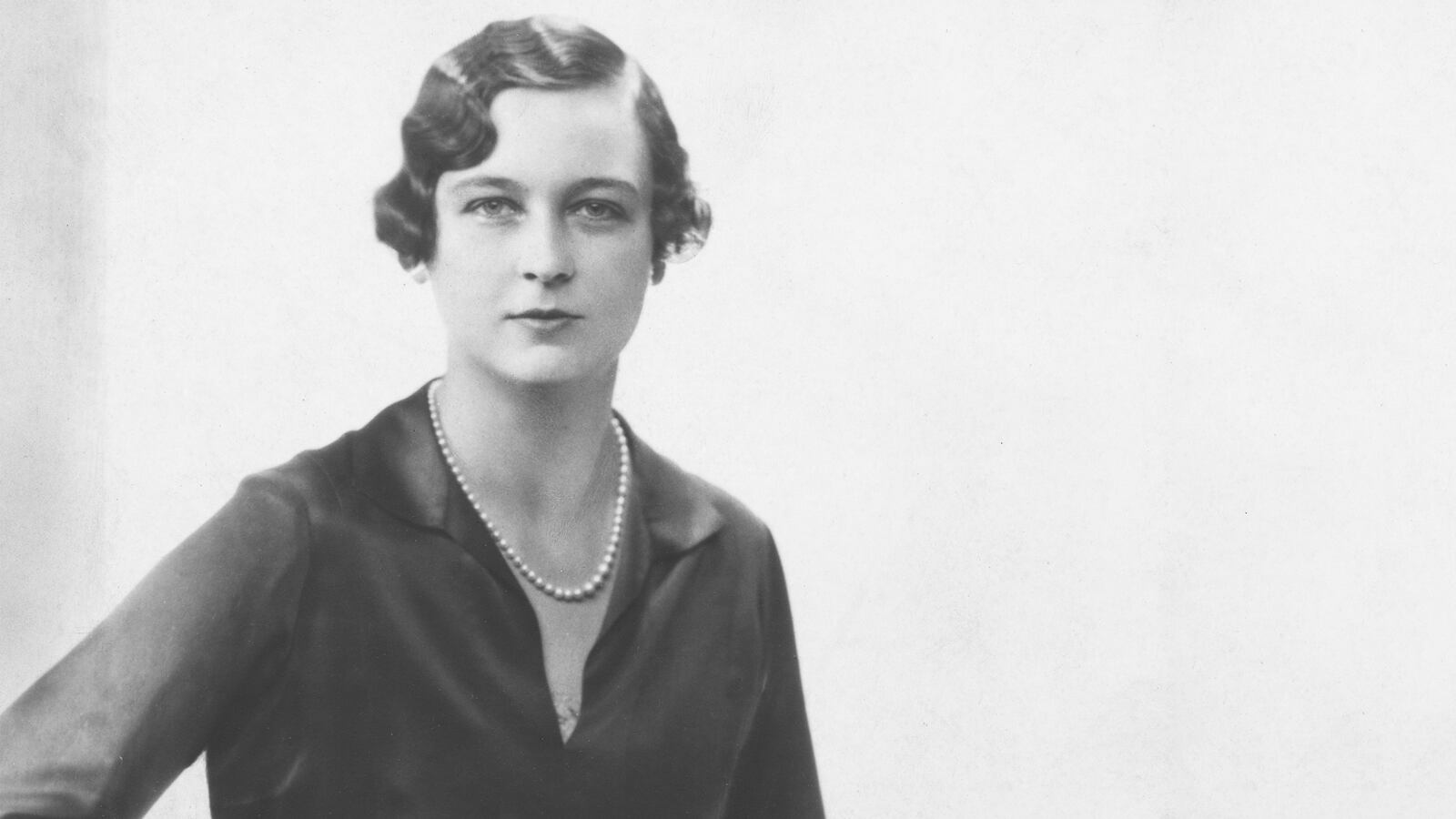F. Scott Fitzgerald never met Henrietta Bingham, which is too bad, because she would have inspired a Jazz Age anti-heroine more beguiling than Daisy Buchanan and Nicole Diver combined.
Tall and self-possessed, Henrietta Bingham oozed sex appeal and charisma, seducing men and women with her Kentucky drawl and coquettish gaze.
One besotted poet wrote that she “looks the memory of her eyes into you… the eyes of a too-wise little girl.”
Lovers and friends swooned possessively over those eyes: Academy Award-winning actor and producer John Houseman, to whom Henrietta was briefly engaged, declared them “violet-blue,” while the novelist David Garnett called them “brilliantly blue.”
But Henrietta Bingham’s legend extends well beyond her looks.
She befriended and bewitched some of the most influential artists, writers, intellectuals, and actresses of her time—from Dora Carrington to Tallulah Bankhead—and became a beloved American fixture in London’s Bloomsbury Group.
She also sang, played the saxophone, and brought her love of black musicians to upper-class London.
She could have been an enigmatic anti-heroine in Jazz Age literature, but it is perhaps more fitting that she is now memorialized as a real-life heroine in Irrepressible: The Jazz Age Life of Henrietta Bingham, out today.

Irrepressible evokes a film-like experience of the roaring ‘20s: the camera panning around a noisy, smoke-filled drawing room overflowing with fabulous people in flapper dress; alighting on the bubble and fizz of freshly poured champagne, clips of conversations between Bloomsbury Group mainstays, and Henrietta Bingham’s batting eyelashes.
Born into enormous wealth as the daughter of Robert Worth Bingham, a Kentucky newspaper publisher, Henrietta bucked social convention as a student at Smith College, where she became romantically involved with one of her young professors, Mina Kirstein Curtiss.
Curtiss brought her to London and coaxed her to the couch of a young analyst named Ernest Jones, a well-known contemporary of Freud.
Henrietta’s biographer and great-niece, the historian Emily Bingham, writes that Curtiss “felt such a mix of heat and shame toward Henrietta that she scrubbed nearly every suggestion of their relationship from her papers.”
It was likely a projection of her own feelings that Curtiss hoped she and Jones would “cure” Henrietta of her homosexual tendencies—not a top priority for Jones.
Indeed, Curtiss did not keep a single letter from Henrietta. Nor did Houseman. But in the early stages of researching her book, Emily Bingham found nearly 200 love letters in one of her great-aunt’s old trunks, including one in which Houseman wrote: “you spoil the world for anyone who has been intimate with you. You are far too exciting.”
Houseman was more explicit in his diaries, recalling “the warm, quick, eager motion of her tongue deep inside my mouth” during one of their last trysts.

Stephen Tomlin, a bisexual sculptor in the Bloomsbury set, wrote to Henrietta that receiving her letters from Kentucky “let loose the dogs of longing at my vitals again.”
Bingham found fewer letters from Henrietta’s female lovers, like Bloomsbury artist Dora Carrington, who sketched Henrietta in the nude in 1924.
But in letters to a close friend, Carrington detailed her feelings for Henrietta, who made her experience “ecstasy” for the first time and aroused in her powerful “physical gestures.”
The trunk contained only one trace of her romance with world tennis champion Helen Hull Jacobs—a monogrammed tennis outfit—who was at the height of her career when she and Henrietta became an item.
Henrietta had an emotionally dependent, almost Oedipal relationship with her widowed father. (Bingham writes that Henrietta “vomited for five straight hours” upon learning her father was remarrying.)
He was threatened by some of Henrietta’s female lovers—namely Curtiss, whom he banished from their house—and fostered their unhealthy dynamic. (“Hyperbole, exaggerated expectations, shame—these were Judge Bingham’s typical modes of communicating with his daughter,” Bingham writes.)
But he was keen on Henrietta spending time with Jacobs and didn’t interfere with their five-year romance.
Much of the book is devoted to the influence of Freudian analysis not just on Henrietta, who opened up to Dr. Jones about her father and her lesbian desires, but on an entire generation. We know it has limitations today, but in the ‘20s it offered a language and space to talk about personal history and same-sex desire.
She recalls her grandmother, wife of Henrietta’s brother Barry Bingham, referring to her great-aunt as an “invert.”
“That was the pre-Freudian conception of homosexuality,” she says.
Bingham’s grandmother made this reference in the ‘90s, when Bingham began acquiring an oral history of the family through her. “I was interested in women’s lives from a historical lens,” she says.
Bingham knew vaguely about Henrietta’s sexual fluidity and her “quite scandalous” relationship with Curtiss. When she learned about her great-aunt’s forays into analysis, she rang up the British Psychoanalytical Association, an institution that was founded in the ‘20s and is still running today. They sent her a package of letters and papers, including a missive from Curtiss to Dr. Jones.
“I had to lie down,” Bingham jokes. There were also notes about Henrietta’s “first real affair,” as Bingham puts it, with a married woman in Louisville who “had become a rather wealthy prostitute!”
One day, she ventured up to the drafty attic in her empty childhood home searching for a trunk of her great aunt’s belongings.
“I turned on an overhead light, brought in a stool, and went through every single thing in there, one by one,” she recalls.
Bingham pulled out one fantastic feather boa after another, along with many other treasures and curiosities Henrietta had kept.
By the end of the day she was exhausted, her fingers numb from the cold. But she had noticed another trunk, this one filled with books, including a first edition of Virginia Woolf's The Years. Its contents were seemingly endless, like Mary Poppins’ bag.
“I was about to fall into this tall trunk,” she says, laughing, when she grazed the top of a stack of hundreds of letters in perfect condition, still in their postmarked envelopes.
She’d heard stories about Henrietta, but they revealed nothing of the woman who emerged in these letters.
“Henrietta’s story and her own sexual fluidity—the impossibility of completely pinning her down—is very zeitgeisty right now,” says Bingham. “I think there’s a parallel to our time where sex and sexual identity is becoming such an overwhelming part of the cultural discourse.”
“But she’s also someone who didn’t make it,” Bingham adds, referring to her great aunt’s death in 1968 aged 67, when Emily was three, after succumbing to a daily cocktail of amphetamines, sedatives, and alcohol.
“It wasn’t just a failure of character—it was extraordinarily complicated. It had to do with the times. It had to do with drugs and her own demons,” she says.
“We should hold up biographical icons not just as heroes but as human beings. We want role models, but we also need a human being to know that we can be forgiven and understood.”






